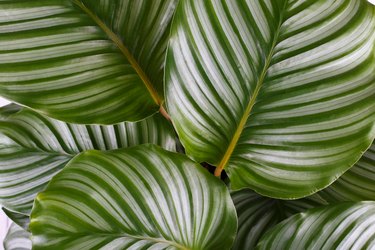
Before investigating zebra plant (Aphelandra squarrosa) propagation, determine if your plant is actually a plant or a succulent. Zebra succulents (Haworthia fasciata) have leaves that look like an aloe with white stripes, and, while they come from the same sub-group and originated in South Africa, they are considered a rare species. Therefore, if yours is healthy and flourishing, propagating the indoor succulent in water is an effective and economical way of extending your collection. The leafy Aphelandra squarrosa has shiny dark green leaves boasting white stripes. It too can be propagated by rooting a leaf in water.
Propagating a Zebra Plant
Video of the Day
The dramatic zebra plant boasts foliage that produces 6 to 9-inch green leaves variegated with white, cream or silvery stripes emanating from the central vein. Hardy in U.S. Department of Agriculture zones 11 and 12, the Aphelandra squarrosa plant is best suited to an indoor environment that approximates its native Brazilian jungle. And since most of us don't like the temperatures found in a jungle, a short life expectancy is what you should expect from the plant.
Video of the Day
Propagating the plant from a leaf is possible if you make a clean cut where the leaf attaches itself to the stem. Use a rooting hormone on the cut and let it dry. Place several leaves in a container of water, but don't cover the leaf itself, just the stem. In a few weeks, roots appear and the leaf is ready for repotting into an African Violet potting mix.
Propagating an Indoor Zebra Succulent
Identify several leaves that appear large and healthy. Remove them from the stem carefully, making the cut as clean as possible. Let the leaves dry for several days, then apply a rooting hormone to the cut ends. Take a piece of plastic wrap and cut a hole just large enough to hold the leaf, poke the leaf through the hole and place it in a jar of water. This prevents the leaf from falling into the water and allows just the stem to propagate.
Place the jar in a bright spot and, even if the leaves don't touch the water, the roots will sense that it's there and after a few weeks will start to reach for it. Wait until a healthy amount of roots develop before replanting into a succulent potting soil. Ultimately the original leaves will wither and dry out; they will either fall off or you can cut them away.
Growing Zebra Plants and Succulents
Whether your plant or succulent has been propagated via cuttings placed in water, once they are ready for potting, the baby plants need special care. The succulent needs sun but not direct sunlight, dry air and little water. Overwatering will kill the roots. It's interesting to note that when a succulent's leaves start to drop, just leaving them on top of the soil and misting occasionally will promote root growth.
Unlike the succulent, the Aphelandra squarrosa plant loves water and should never be allowed to sit in dry soil. High humidity is essential to growth and placing a dish with water under the plant pot adds humidity to its environment. Frequent misting and wiping the leaves often to rid them of dust keeps the leaves shiny and healthy. Maintain a room temperature of between 68-75 degrees Fahrenheit. If optimum conditions are given the plant, you'll be rewarded with a stunning yellow flower growing from each bract.